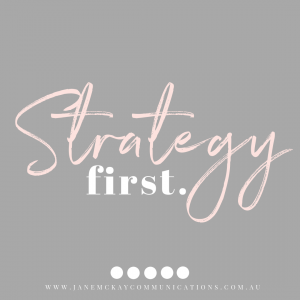 A strategic marketing plan is an essential part of growing your business and a reference point to consistently market your business each day, week, month, quarter and year.
A strategic marketing plan is an essential part of growing your business and a reference point to consistently market your business each day, week, month, quarter and year.
A strong marketing strategy is the foundation of marketing success: if you don’t have a strategy you won’t be able to measure your success. Marketing without strategy is like throwing mud at a wall and seeing what sticks: there’s no plan, there’s no measurement, it’s completely ad hoc and random and (in the vast majority of cases) ineffective.
What is a strategic marketing plan?
A strategic marketing plan is basically a document that takes you from where you are now to a clearly defined point in the future; it's effectively a map that takes you from where you are, "Point A" to your goal "Point B".
The strategy gives you an idea of what you will achieve and the tactics that support your strategy gives you the how. When you put your strategy and tactics together you have a strategic marketing plan. The why of a marketing plan is defined by your business' vision and mission.
The aim of a strategic marketing plan is to give a clear picture of what you are going to achieve in your business in the chosen period (I recommend 12 months) and how you are going to achieve it to maintain a steady flow of customers to keep you on track to reach your revenue and profit goals.
A strategic marketing plan also gives everyone in your organisation an understanding of what you are aiming to achieve with your marketing: your brand positioning, your target audience and the marketing projects you are going to undertake over the next 12 months to achieve your strategy.
While it is tempting to not document your marketing plan, you are 42% more likely to achieve your goals if you write them down. By writing down your plan, you're (almost) halfway there!
In this article I’ve tried to simplify the marketing planning process so that it doesn’t become an overwhelming task, as if it’s overwhelming, it simply won’t get done (in my experience). Or done and promptly set aside (amirite?).
The aim is for this strategic marketing plan to be something easy and fun to deal with (because marketing is fun) and something you refer to regularly in your business so that you know you are on track to reach the amazing goals you have for your business!
Click here to download your free Strategic Marketing Plan Template Workbook
Overview of your strategic marketing plan:
- Goals: Set yourself some goals for your amazing 12 months in business!
- Target audience: Know thy audience! The most important marketing task you will undertake in your business is defining your dream clients!
- Brand position: Where are you at? Where do you want to be?
- Situation analysis: What are the internal and external factors that affect your business?
- Define your strategy: What are the marketing strategies you need to undertake to achieve your goals?
- Tactical marketing mix: What tactics and distribution channels will you use to achieve your strategy?
- Measurement: How are you going to measure your success?
How to write a strategic marketing plan
-
Set your 12-month goals
By documenting your goals you have an end-point you are trying to reach in a specific time frame. Aim for growth that is reachable, but still a challenge.
Create 7-day and 1-, 3- and 6-month milestones to make your goals more digestible and ensure that your goals tie-in to your business’ mission and vision.
Select some qualitative and quantitative goals and write them in your workbook.
-
Target Audience
The next step to any successful marketing plan is to know your audience! Knowing who you are talking to, their motivations, their fears and frustrations and their aspirations is the foundational piece that is often missing from many small business marketing plans.
If you haven't completed your audience research, I strongly recommend downloading my free "Dream Client Workbook" and meticulously working on that piece of your marketing puzzle.
Define your target audience or "buyer persona" in the workbook. If you have more than one buyer persona - choose your favourite type of customer to work with first. I call these gorgeous humans my “dream clients”.
-
Brand Position
Your brand positioning contextualises your brand to your dream clients.
- Where are you in the market, right now?
- What differentiates you from your competitors?
- Why does your target audience choose you over your competitors?
- How is your brand perceived in your market?
- How is this different from where you want your business to be perceived?
This all contributes to your position in the market in which you operate or how your brand sits in your customers’ minds.
-
SWOT Analysis
Some people perceive SWOT as pretty old-school marketing and it is! But the reason it has persisted is that it gives you a new perspective of how your brand is perceived in the market.
SWOT is an acronym that stands for strengths, weaknesses, opportunities, and threats.
A SWOT analysis helps you understand internal and external factors that affect your business and your marketing. SWOTs are old school marketing but they are a really useful way to get a bird’s eye view of your business and any internal and external factors that affect your performance, growth and, ultimately, profits.
The SWOT analysis process is a brainstorming technique. It’s designed to help you understand what might differentiate you from your competition and what resources you have to execute upon any opportunities. In the same breath, the SWOT framework helps you understand what might prevent you from seizing an opportunity.
The four areas it encompasses are devised to help you explore internal and external factors:
- Internal (your resources)
- Strengths
- Weaknesses
- External (market, competition, any government or environmental factors, etc.)
- Opportunities
- Threats
- What are your strengths compared to your competitors?
- What are your weaknesses compared to your competitors?
- What external opportunities are likely to come up in the next 12 months?
- What external threats are likely to arise in the next 12 months?
-
Marketing strategies
Reflecting on your analysis of your target audience, your brand position and your SWOT analysis, what are the most realistically achievable or important goals you identified in step 1?
Choose the top 3-5 and these will become your marketing strategies for the next 12 months.
Write them down in the workbook. You might want to expand, refine or define these further.
-
Tactical marketing mix
If one of your strategies is to increase customer retention and repeat sales, how will you do this? What are the activities you need to undertake to achieve your strategies?
The answer to this question will form the nuts and bolts of your tactical marketing plan. Ask yourself: what marketing activities am I going to use to achieve my goals?
For each of your strategies, identify some tactics you can use to achieve these goals. Think about the main drivers of sales in your business and set yourself some goals.
Every time you identify a tactic you must consider: How is this helping me to achieve my strategy?
Focus on the money-making activities first. While you may love Instagram if it’s not driving traffic to your website or generating enquiries and sales it goes way down the list.
If your strategy is to increase customer retention and repeat sales, your tactics could include:
- Create a customer loyalty discount program
- Create an email follow-up sequence for customers who have made a purchase with relevant products
- Create a subscription-based service
If you do each of these you will increase customer retention and repeat sales.
Sounds simple enough? Write down your marketing tactics for each strategy in your workbook.
Fave tool: I map out my entire marketing strategy in Airtable which I LOVE (it’s sort of a cross between Excel and Trello) including all my core content, social media posts and Facebook group contributions.
-
Measurement
How will you know you are achieving your goals if you don’t measure them? Identify some KPIs, key performance indicators or measurements you can track to ensure you are getting good ROI on your marketing.
If one of your tactics was to improve your SEO to increase website traffic by 20%, make sure you have the tools in place i.e. Google Analytics, to measure your marketing efforts (and then give yourself a high-five each time you achieve a milestone!). Note these KPIs in your workbook.
That’s it! Strategic marketing plan: smashed! I hope you are excited by your goals and brimming with ideas on how you are going to make these a reality.
Don’t forget to download the workbook.
Listen to the Podcast:



